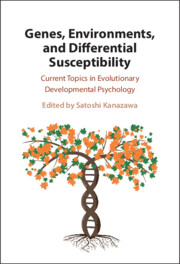 Genes, Environments, and Differential Susceptibility
Genes, Environments, and Differential Susceptibility Book contents
- Genes, Environments, and Differential Susceptibility
- Genes, Environments, and Differential Susceptibility
- Copyright page
- Contents
- Figures
- Tables
- Contributors
- Introduction
- Part I Historical Background and Theoretical Foundations of Jay Belsky’s Work in Evolutionary Developmental Psychology
- Chapter 1 How Belsky’s Model of Child Abuse Has Transformed Scientific Understanding, Clinical Practice, and Public Policy
- Chapter 2 A Turning Point for the Life History Approach to Individual Differences
- Chapter 3 Individual Differences in Response to the Environment
- Part II Parent–Child Relations and Attachment
- Part III Life-Course Development from Prenatal Environment through Childhood to Adulthood
- Part IV Differential Susceptibility to Environmental Influences
- Conclusion
- Afterword
- Biography of Jay Belsky
- Index
- References
Chapter 2 - A Turning Point for the Life History Approach to Individual Differences
from Part I - Historical Background and Theoretical Foundations of Jay Belsky’s Work in Evolutionary Developmental Psychology
Published online by Cambridge University Press: 04 September 2025
- Genes, Environments, and Differential Susceptibility
- Genes, Environments, and Differential Susceptibility
- Copyright page
- Contents
- Figures
- Tables
- Contributors
- Introduction
- Part I Historical Background and Theoretical Foundations of Jay Belsky’s Work in Evolutionary Developmental Psychology
- Chapter 1 How Belsky’s Model of Child Abuse Has Transformed Scientific Understanding, Clinical Practice, and Public Policy
- Chapter 2 A Turning Point for the Life History Approach to Individual Differences
- Chapter 3 Individual Differences in Response to the Environment
- Part II Parent–Child Relations and Attachment
- Part III Life-Course Development from Prenatal Environment through Childhood to Adulthood
- Part IV Differential Susceptibility to Environmental Influences
- Conclusion
- Afterword
- Biography of Jay Belsky
- Index
- References
Summary
The life history approach to individual differences has become a major influence in evolutionary psychology, not least thanks to the contributions made by Jay Belsky and his collaborators over the last three decades. Today the approach is at a turning point, with a lively dialectic between proponents and critics and a menu of theoretical and empirical challenges to address. In this chapter, I follow up on previous work and continue to critically examine the concepts and assumptions of the “fast-slow paradigm” in evolutionary psychology. Specifically, I try to clarify some aspects of the interplay between the demographic and psychological levels of analysis, make an updated case for the centrality of the mating–parenting tradeoff in the organization of life history-related traits, describe the constellations formed by those traits, introduce the notion of multiple fast/slow profiles, and (re)consider the role of puberty timing in relation to human life history strategies. Preserving the value of the life history approach demands that we work to keep the foundations healthy – constantly revising our concepts and assumptions, in the spirit of Jay’s remarkable scientific career.
Keywords
Information
- Type
- Chapter
- Information
- Genes, Environments, and Differential SusceptibilityCurrent Topics in Evolutionary Developmental Psychology, pp. 28 - 57Publisher: Cambridge University PressPrint publication year: 2025
References
Accessibility standard: WCAG 2.0 A
Why this information is here
This section outlines the accessibility features of this content - including support for screen readers, full keyboard navigation and high-contrast display options. This may not be relevant for you.Accessibility Information
Content Navigation
Allows you to navigate directly to chapters, sections, or non‐text items through a linked table of contents, reducing the need for extensive scrolling.
Provides an interactive index, letting you go straight to where a term or subject appears in the text without manual searching.
Reading Order & Textual Equivalents
You will encounter all content (including footnotes, captions, etc.) in a clear, sequential flow, making it easier to follow with assistive tools like screen readers.
You get concise descriptions (for images, charts, or media clips), ensuring you do not miss crucial information when visual or audio elements are not accessible.
You get more than just short alt text: you have comprehensive text equivalents, transcripts, captions, or audio descriptions for substantial non‐text content, which is especially helpful for complex visuals or multimedia.
Visual Accessibility
You will still understand key ideas or prompts without relying solely on colour, which is especially helpful if you have colour vision deficiencies.
You benefit from high‐contrast text, which improves legibility if you have low vision or if you are reading in less‐than‐ideal lighting conditions.
- 1
- Cited by